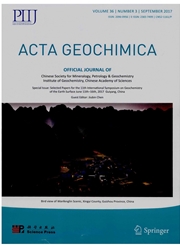

 中文摘要:
中文摘要:
Yitong 盆是有在东北中国的唯一的特征的含有石油的盆。根据磷灰石分裂轨道年龄和地质的关系,构造高举自从渐新世, Yitong 盆的历史被讨论。从 Luxiang 和 Chaluhe 差错消沉和盆建模学习基于五件样品的磷灰石分裂轨道分析,自从在 Yitong 盆的渐新世(36.6 妈) , Chaluhe 差错消沉经历了二个事件,这能被结束在 24.919.1 妈和 6.94.9 妈期间高举。并且 Luxiang 差错消沉也经历了二个事件在 3027.8 妈和 22.611.1 妈期间高举。而且,为 Chaluhe 差错消沉和 Luxiang 的平均明显的发掘率指责消沉,自从 21.8 妈和 18.9 妈,能分别地被计算是 70.34 和 60.33 m/Ma。thermochronological 分析的结果能被证据也从象地球动力学,暴烈的活动,和 stratigraphic 分割和关联那样的地质的关系支持。
 英文摘要:
英文摘要:
The Yitong Basin is an oilbearing basin with unique characteristics in Northeast China. On the basis of apatite fission track ages and geological relationship, the tectonic uplift history of the Yitong Basin since the Oligo-cene was discussed. Based on apatite fission track analysis of five samples from the Luxiang and Chaluhe fault depressions and basin modeling study, it can be concluded that since the Oligocene (36.6 Ma) in the Yitong Basin, the Chaluhe fault depression has undergone two episodes of uplift during 24.9-19.1 Ma and 6.9-4.9 Ma. And the Luxiang fault depression also had undergone two episodes of uplift during 30-27.8 Ma and 22.6-11.1 Ma. Moreover, the average apparent exhumation rates for the Chaluhe fault depression and Luxiang fault depression, could be calculated to be 70.34 and 60.33 m/Ma since 21.8 Ma and 18.9 Ma, respectively. The results of thermochronological analysis can also be supported by the evidence from geological relationships such as geodynamics, volcanic activity, and stratigraphic division and correlation.
 同期刊论文项目
同期刊论文项目
 同项目期刊论文
同项目期刊论文
 期刊信息
期刊信息
